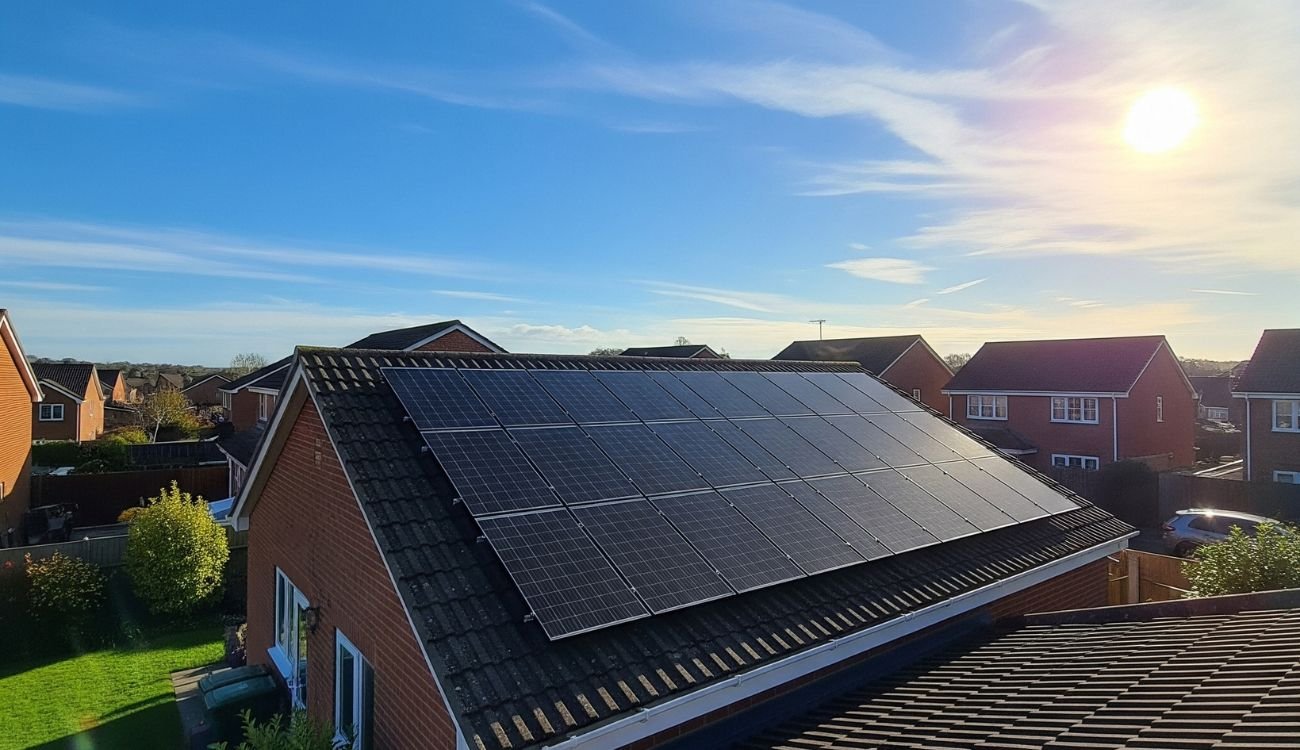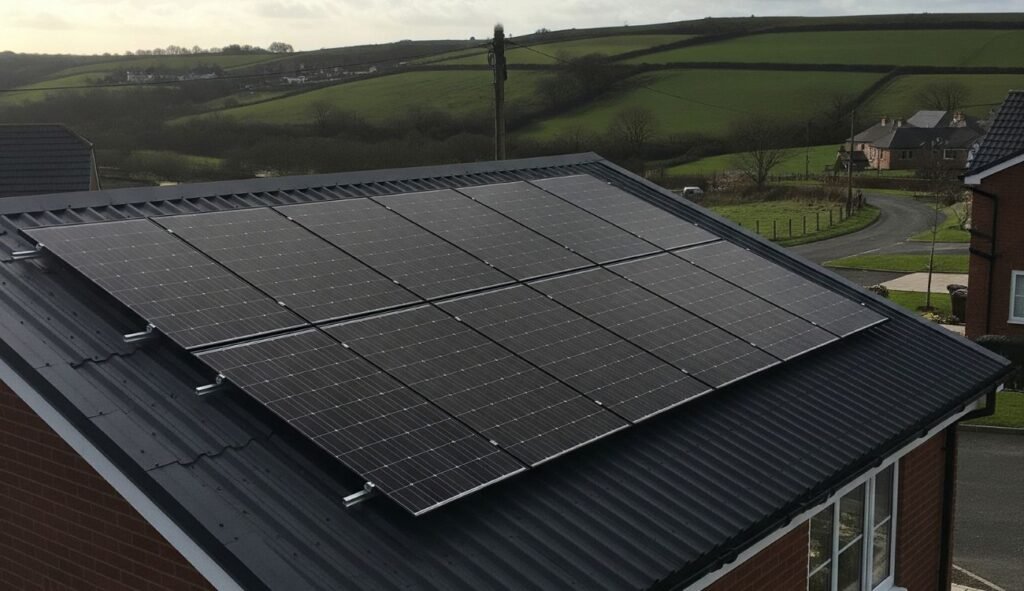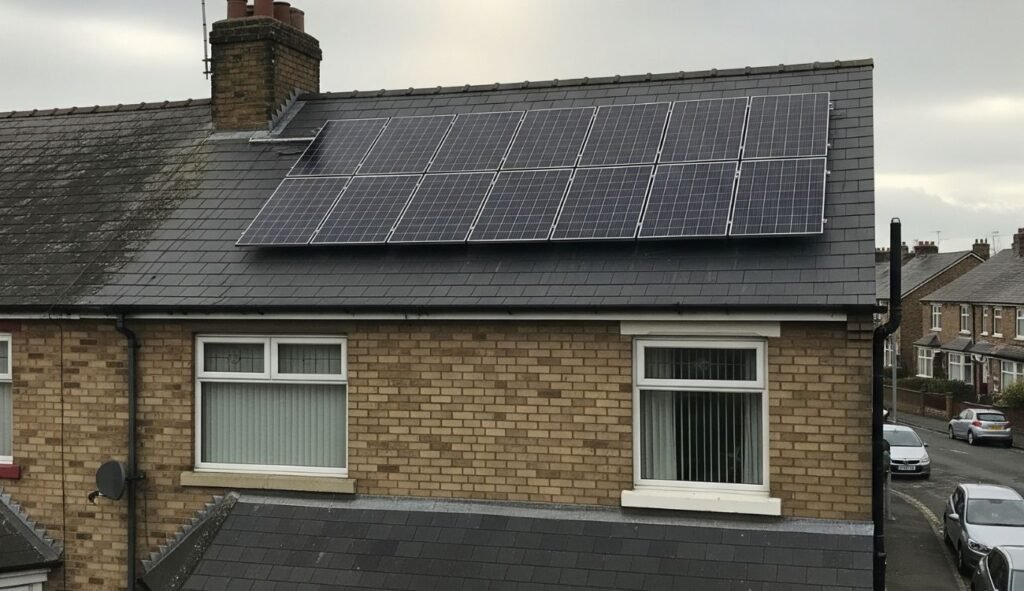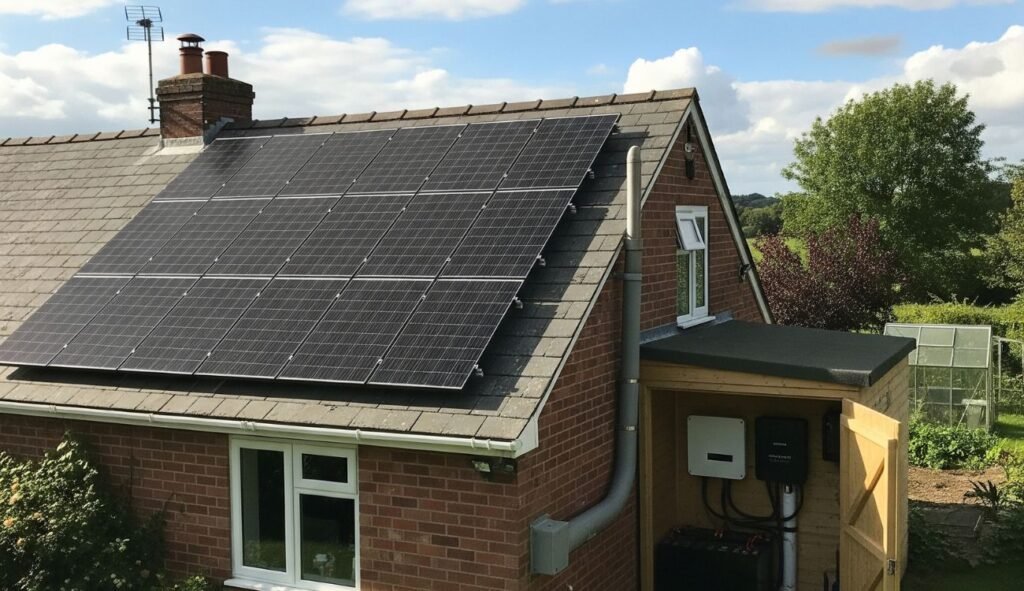With more UK homeowners and landlords turning to solar panels to reduce energy bills and carbon footprints, it’s only natural to have questions about performance in extreme weather. One such concern is: can it get too hot for solar panels?
While solar panels rely on sunlight to generate electricity, it’s not always as straightforward as “the more heat, the better.”
In this article we’ll discuss how high temperatures impact solar panel efficiency, what this means in a UK context, and how you can make a confident investment in solar energy.
Do Solar Panels Lose Efficiency in High Temperatures?
Yes, solar panels can become less efficient as temperatures rise. While they need sunlight to operate, excessive heat can actually reduce their ability to convert that sunlight into usable electricity. This is an important distinction, solar panels thrive on sunlight, not heat.
The UK has been experiencing increasingly hotter summers in recent years due to climate change.
According to the UK Met Office, the summer of 2022 was the hottest on record, and extreme heat events are becoming more common, with temperatures now regularly surpassing 30°C across much of England.
While this may seem like a positive for solar energy generation, the reality is more complex.
What Is the Temperature Coefficient?
This is where the temperature coefficient comes into play, a specification that tells us how much a panel’s efficiency drops for every degree Celsius above 25°C, which is the industry standard for performance testing.
Most solar panels have a temperature coefficient between -0.3% and -0.5% per °C. This means for every degree above 25°C, you could lose up to half a percent of output.
For example, if the panel surface temperature rises to 35°C, its power output may drop by 3–5%. On particularly sunny days, panel surface temperatures can exceed 50°C, leading to even greater temporary losses.
This might not seem significant, but across an entire solar array, especially during peak demand periods, it can reduce the overall energy harvested and therefore your potential savings.
Why Does Solar Panel Efficiency Drop in Extreme Heat?
At a technical level, as temperature increases, the voltage of the solar panel drops, while the current increases slightly. However, this rise in current isn’t enough to offset the loss in voltage, resulting in a net reduction in power output (since power = voltage × current).
Unlike appliances such as batteries or electric motors that might warm up to perform optimally, solar photovoltaic (PV) systems actually dislike excessive heat.
The silicon cells inside the panels operate most efficiently in cooler conditions, which is why countries like Germany, the Netherlands, and the UK, despite their cloudier climates still achieve excellent solar energy output.
Why This Matters in the UK
While the UK was once seen as a “mild” climate for solar, things are changing. The Committee on Climate Change (CCC) warns that average summer temperatures are projected to rise by 1.4°C to 5.8°C by 2070.
This means that solar panel systems must be designed with increasing heat in mind, even in areas like Tyne and Wear or Newcastle, where high summer temperatures were once rare.
Professional solar installers like Future Heat already factor this into their system designs.
Using high-efficiency panels with lower temperature coefficients, ensuring adequate ventilation, and selecting the right mounting systems are all essential for optimising solar performance during hotter periods.
How Hot Do Solar Panels Get in the UK?
In the UK, it’s rare for temperatures to reach extremes that would severely impact solar performance. Even during heatwaves, ambient air temperatures rarely exceed 35°C.
However, the surface temperature of solar panels can be 20°C hotter than the surrounding air, meaning a panel might reach 50-60°C on a sunny summer day.
According to the Energy Saving Trust, solar PV systems are still highly effective in the UK, producing energy even on cloudy days. Our climate provides the perfect balance of sunlight without the scorching extremes seen in countries like Australia or parts of the US.
How Much Efficiency Do Solar Panels Lose As Temperatures Rise?
Solar panel efficiency losses aren’t usually catastrophic, but they can add up, especially during prolonged heatwaves.
The table below illustrates how different temperatures can affect the performance of a typical solar panel with a temperature coefficient of -0.4% per °C (a common rating for many panels used in the UK).
| Panel Temperature (°C) | Degrees Above 25°C | Efficiency Loss (%) | Remaining Efficiency (%) |
|---|---|---|---|
| 25°C (Standard Condition) | 0°C | 0% | 100% |
| 30°C | +5°C | -2.0% | 98% |
| 35°C | +10°C | -4.0% | 96% |
| 40°C | +15°C | -6.0% | 94% |
| 45°C | +20°C | -8.0% | 92% |
| 50°C | +25°C | -10.0% | 90% |
| 60°C | +35°C | -14.0% | 86% |
Note: These figures are approximate and assume a -0.4%/°C coefficient. Some premium panels have better coefficients (as low as -0.26%), while budget options may be less efficient under heat.
Can High Temperatures Cause Damage to Solar Panels?
In the UK, the likelihood of heat physically damaging solar panels is extremely low. Modern panels are tested under extreme conditions and can typically withstand up to 85°C during laboratory testing.
However, prolonged exposure to extreme heat over many years may accelerate the ageing process of solar panels. This is why it’s vital to choose panels from a reputable manufacturer with strong warranties (typically 25 years or more) and to work with MCS-accredited installers.
Degradation is more commonly associated with UV exposure and general wear over decades rather than occasional summer spikes in temperature.
Do Solar Panels Shut Down If They Get Too Hot?
No, solar panels do not shut down if they get too hot, but their performance may decline slightly due to thermal efficiency losses.
It’s a common misconception that high temperatures can cause solar systems to stop working altogether. In reality, modern photovoltaic (PV) systems are engineered to withstand a wide range of environmental conditions, including elevated surface temperatures.
Operating Temperature Tolerance
Most quality solar panels used in the UK are designed to operate safely in surface temperatures of up to 85°C. This upper limit is well above what panels typically experience, even during heatwaves.
Instead of shutting down, panels respond to heat through the temperature coefficient. This reduction is gradual and predictable, allowing installers to design systems that anticipate and compensate for minor summer losses.
Inverters, which convert DC to AC electricity may also include built-in thermal regulation features to prevent overheating.
In rare cases where internal component temperatures exceed safety thresholds, the inverter may throttle or pause momentarily to prevent damage, but this is a protective feature, not a failure of the system.
System Design to Prevent Overheating Issues
Properly designed UK solar installations factor in expected seasonal highs and mitigate overheating risk through:
- Panel elevation for better airflow
- Selection of panels with lower temperature coefficients
- Use of smart inverters with adaptive cooling
- Strategic spacing and layout to reduce heat build-up
Installers like Future Heat, who serve Tyne and Wear, Newcastle, and the North East, take these elements into account to ensure year-round reliability, even as UK summers continue to warm.
Are Certain Solar Technologies More Heat-Resistant?
Yes, different solar panel technologies react to heat in different ways, and choosing the right type for your property can help minimise efficiency losses during hot weather.
In the UK, while extreme heat isn’t a daily concern, summers are becoming warmer and longer due to climate change.
Choosing the right panel technology is therefore becoming increasingly relevant, not just for sunny climates abroad, but for homes and businesses right here in the UK.
Below we’ll discuss how the three main types of solar panel technologies handle high temperatures:
Monocrystalline Panels
- Description: Made from a single crystal structure of silicon, monocrystalline panels are known for their high efficiency and sleek black appearance.
- Temperature Coefficient: Typically around -0.3% to -0.4% per °C.
- Heat Performance: These panels are slightly more sensitive to heat compared to thin-film panels, but they still perform very well in UK conditions thanks to their overall efficiency and durability.
- Best For: Homes with limited roof space where you want to maximise output per square metre. They’re also ideal for homeowners looking for long-term performance and visual appeal.
- UK Context: Monocrystalline is the most commonly used panel type in the UK. Despite moderate heat sensitivity, their high overall output often makes up for temporary drops in performance during hotter spells.
Polycrystalline Panels
- Description: Constructed from multiple silicon crystals, polycrystalline panels have a bluish hue and a more fragmented appearance.
- Temperature Coefficient: Generally around -0.4% to -0.5% per °C.
- Heat Performance: Slightly less efficient overall and more susceptible to heat-related losses than monocrystalline panels.
- Best For: Budget-conscious installations where cost is more important than maximum efficiency, such as rental properties or commercial spaces with ample roof space.
- UK Context: While less common in new residential installations, they may still be offered as a low-cost option. In hotter UK summers, their reduced heat tolerance should be factored into performance expectations.
Thin-Film Panels
- Description: These panels use a different manufacturing process, applying photovoltaic materials in a thin layer on a substrate like glass or metal. They’re lightweight and often flexible.
- Temperature Coefficient: As low as -0.2% per °C, meaning they lose less efficiency in hot conditions.
- Heat Performance: Much more tolerant of high temperatures, making them ideal for large, well-ventilated surfaces. However, their lower base efficiency means you’ll need significantly more surface area to match the output of crystalline panels.
- Best For: Large-scale commercial or industrial roofs, or properties with unusual roof shapes where traditional panels are difficult to install.
- UK Context: Rarely used in residential projects due to space requirements and lower availability, but could be considered in commercial scenarios where roof size and summer heat exposure are major factors.
How Do UK Solar Installers Account for High Temperatures?
Professional solar installers in the UK, particularly MCS-certified providers like Future Heat, use a combination of design strategies, product selection, and installation techniques to mitigate the impact of heat on solar panel efficiency.
These best practices not only protect system performance but also ensure long-term value for homeowners and landlords.
Panel Positioning and Tilt Angle
Mounting panels at the optimal angle and orientation ensures they receive maximum sunlight while allowing natural airflow underneath.
This airflow plays a crucial role in passive cooling, especially for roof-mounted systems. Flat or overly flush installations can trap heat, so spacing and tilt are adjusted to encourage heat dissipation.
In the UK, most panels are tilted between 30–40 degrees, which not only maximises solar exposure but also helps rainwater run off, reducing dirt accumulation that can further contribute to overheating.
Use of High-Quality Inverters and Components
The inverter is the heart of a solar system, converting DC electricity into usable AC. Advanced inverters, such as those from SolarEdge or SMA, are designed to adapt to changing environmental conditions, including fluctuations in temperature.
Cheaper inverters may struggle under sustained heat, leading to power clipping or system shutdowns.
Quality UK installers use inverters with built-in thermal protection, smart monitoring, and cooling features to preserve system reliability during heatwaves.
Panel Spacing and Air Circulation
Installing panels with a gap between the roof and the underside of the panel is standard practice for most UK installations. This spacing allows for natural ventilation, reducing the risk of hot air becoming trapped and affecting panel performance.
For commercial or flat-roof systems, installers may also use elevated racking systems to boost air circulation even further, a simple yet highly effective way to offset rising surface temperatures.
Selection of Panels With Low Temperature Coefficients
Top UK installers recommend panels that lose less efficiency as temperatures rise. Panels with temperature coefficients around -0.3% or lower per °C are now widely available from premium manufacturers like REC, SunPower, or Q CELLS.
While these panels may have a slightly higher upfront cost, they’re more efficient long-term, especially as UK summers become warmer.
An experienced installer will factor in local climate conditions, roof characteristics, and long-term energy goals when selecting the ideal panel type for your property.
Compliance With MCS Design and Installation Standards
All reputable UK installers should be certified by the Microgeneration Certification Scheme (MCS). MCS standards cover everything from product quality to design considerations for local climate, including how to account for potential overheating risks.
Choosing an MCS-certified installer ensures that your system is:
- Designed with best-practice thermal management in mind
- Installed with products that meet UK performance and safety criteria
- Eligible for financial incentives, like SEG payments or potential grants
Should You Be Concerned About Solar Panel Performance in Summer?
Not particularly. While there is a slight drop in efficiency during heatwaves, solar panels in the UK are optimised to handle a range of conditions.
Reputable installers account for temperature variations when designing your system. By allowing for adequate airflow and using quality materials, they ensure your panels remain within safe operating temperatures year-round.
If you’re in Tyne and Wear, Newcastle, or the North East of England, you can request a free consultation with Future Heat, a trusted solar panel installation provider. They will help assess your property and ensure your solar investment delivers maximum efficiency, no matter the season.
FAQs
Can I use solar panels in areas that experience UK heatwaves?
Absolutely. UK heatwaves are mild compared to global standards. Solar systems are designed to operate across a range of weather conditions, including sunny and hot days.
Does the colour of the roof affect solar panel temperature?
Yes, darker roofs absorb more heat, which can raise panel temperatures. However, good installation practices like air gaps and racking systems offset this effect.
Will installing solar panels make my roof hotter?
Not necessarily. Panels actually create a shading effect on the roof, which can keep the area directly beneath cooler than an exposed roof.
Can battery storage help mitigate heat-related efficiency losses?
Yes. While it doesn’t reduce panel heat, a solar battery system allows you to store excess energy produced earlier in the day when temperatures are lower and efficiency is higher. This can help smooth out supply during hotter hours.
Our Verdict
While it’s true that solar panels lose some efficiency in very high temperatures, this is rarely a major issue in the UK. Our climate is well-suited to solar technology, offering ample sunshine without the excessive heat that challenges systems elsewhere.
By working with a trusted installer like Future Heat in the North East of England, you can ensure your solar panel system is designed for maximum performance, even on the hottest days. Using certified components, strategic positioning, and expert planning, solar power remains a smart, sustainable investment for UK homeowners, landlords, and commercial property owners alike.
Myles Robinson is a seasoned expert in the boiler and home improvement industry, with over a decade of experience. He is deeply committed to environmental sustainability, actively promoting energy-efficient heating solutions to help households reduce their carbon footprint. By combining industry expertise with a dedication to environmental responsibility, Myles continues to lead efforts in transforming home heating practices towards a more sustainable future.











